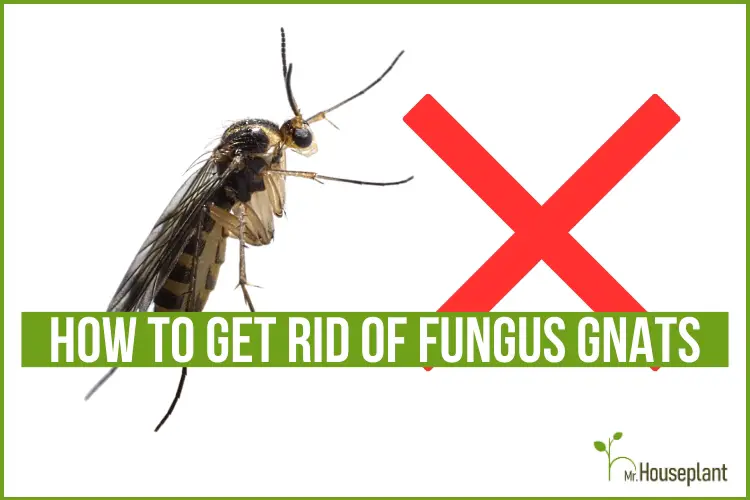
If you grow houseplants, I’m sure you’ve noticed fungus gnats — little flies around your houseplants — at some point and you surely know how big of a nuisance these pests are!
Unfortunately, I also have a lot of experience with fungus gnats, as I’ve had to deal with them both in Serbia and in the United States. While battling them, I tried many things — letting the soil dry out, yellow sticky notes, a layer of sand on top of the soil… but only a few methods gave results I was happy with.
To spare you from going down the same road of testing and trying various methods that may or may not work, I have narrowed them all to these 11 thoroughly tested methods to get rid of fungus gnats in your home. These include products like hydrogen peroxide, Mosquito Bits, and yellow sticky traps, as well as techniques that include nematodes and hydroponics.
You can try whichever method feels most convenient, and don’t worry — if you don’t achieve success with one, you will with another.
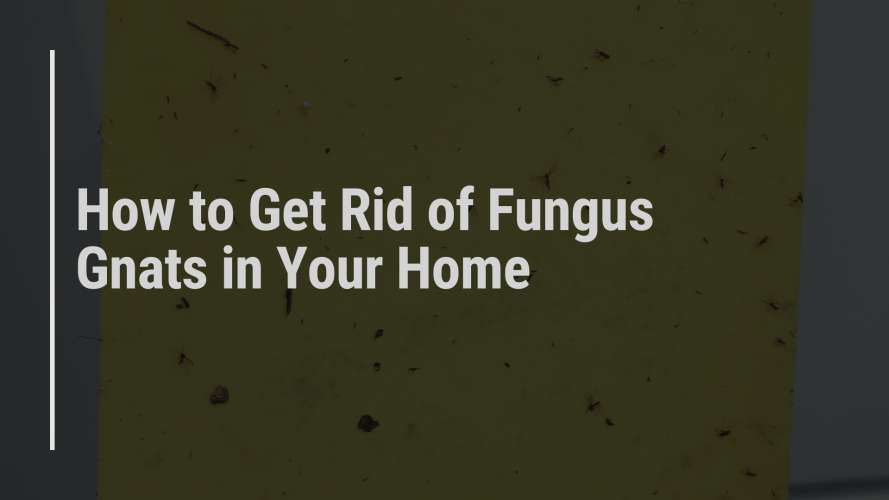
| Mosquito Bits | Contains bacteria that kills larvae | Buy on Amazon |
| Yellow sticky traps | Cacthes and kills adults | Buy on Amazon |
| Systemic insecticide | Kills not only fungus gnats but many other pests | Buy on Amazon |
| Nematodes | Beneficial microscopic nematodes that kill fungus gnats | Buy on Amazon |
| Hydrogen Peroxide | Kills gnat larvae | Buy on Amazon |
| Diatomaceous earth | Kills larvae and adults it contacts | Buy on Amazon |
| Non-organic potting mix | No soil, no fungus gnats | Buy on Amazon |
Fungus gnats are dark (almost black), tiny flies, with small eyes approximately 1/16 of an inch long (around 1.5 mm). Their wings vary from clear to light gray, depending on the species. Fungus Gnats are not very good fliers, as they fly rather erratically, close to people’s faces, especially if they use cell phones or are near a bright source of light. If fungus gnats don’t try to, clumsily, enter your mouth, you will find them on top of the soil, in the top half-inch of the soil, or on the bottom side of the pots, in drainage holes.
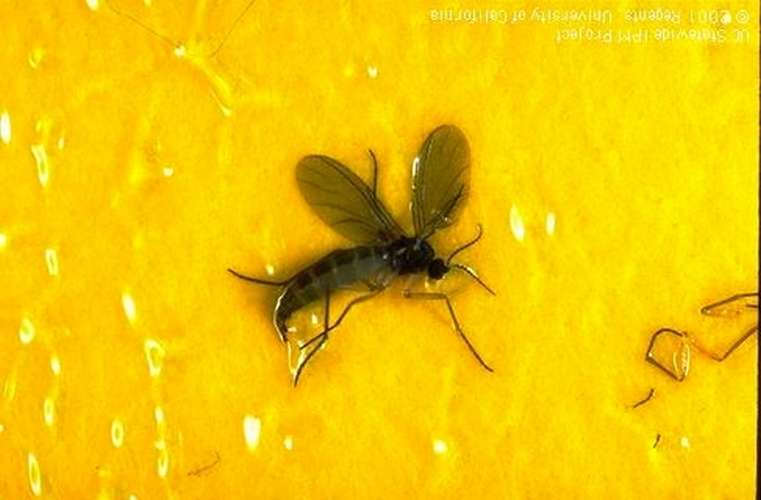
The fungus gnat, caught on a yellow sticky strap, Photo: University of California
People often mistake them for fruit flies. However, as you can see from the image below, they look very different. Fruit flies are brownish-orange, have large red eyes, and usually are found around fruits and vegetables.
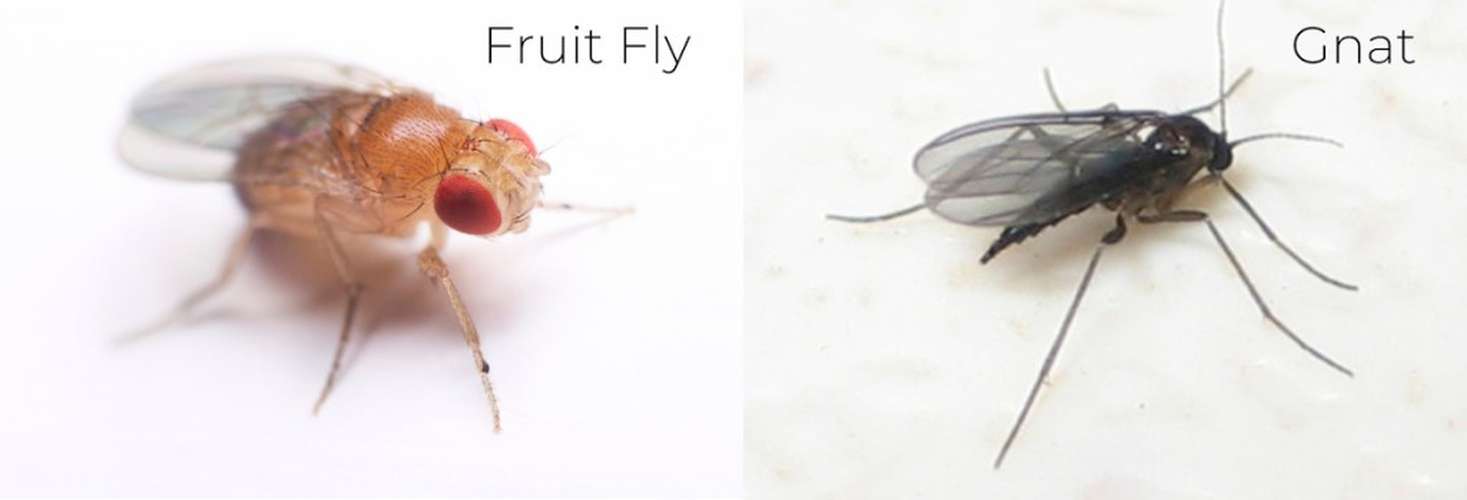
The differences between fruit flies and fungus gnats; image source: https://hip2save.com/
Fungus Gnat Lifecycle
It’s important to learn about the fungus gnats lifecycle to be able to detect them early and remove them as soon as possible.
There are four stages in the fungus gnats lifecycle — egg, larvae, pupae, and adult.
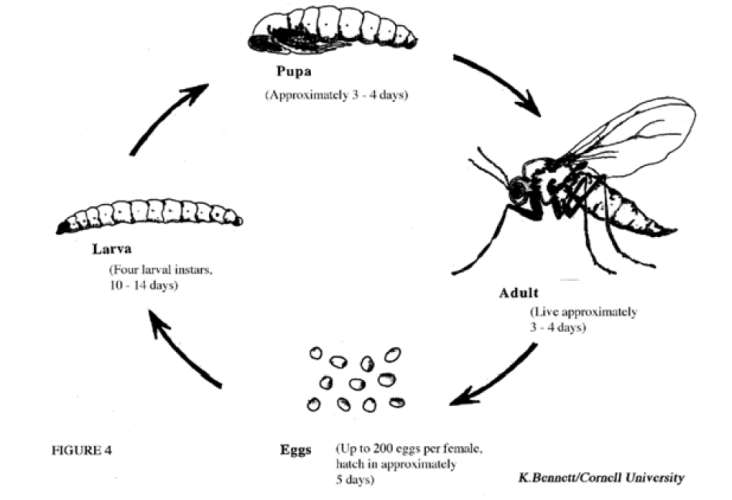
Female fungus gnats lay eggs just in rich and fertile soil. The adult gnats can lay almost 200 eggs in its short lifespan of a few days!
The eggs turn into larvae after 4 to 6 days, which after 10 to 14 days develop into pupae. Pupae are hidden under the soil and mature into a full adult around 3-7 days later. Generally, the adult fungus gnats stay alive for up to a week. They complete one lifecycle in about just a month.
Since most time is spent in the larvae stage, it is important to focus not only on the control and removal of adult gnats but larvae as well.
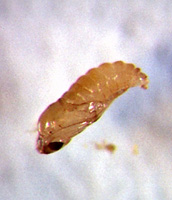
Fungus gnat larvae; image source: University of Florida
Can Fungus Gnats Harm Your Houseplants?
Don’t worry, fungus gnats will not damage your houseplants as they mostly feed on decaying organic matter. Sometimes, when they run out of organic matter, they can begin feeding on roots, but even when they multiply in large numbers, you will not notice any damage to your plants. All in all, fungus gnats in houseplants are more of an annoyance than a true pest problem that will harm your plants.
The Most Effective Methods that will Help You Get Rid of Fungus Gnats
I sorted fungus gnats removal methods based on my experience with their effectiveness. However, what works for one person, might not work for another, for multiple possible reasons. I suggest starting with the first method on the list, and if it doesn’t work for you, simply work your way down the list.
1. Mosquito Bits
Mosquito Bits are a biological way to fight and prevent fungus gnats. The bits are pellets made of corn cob. They contain the bacteria Bacillus Thurigiensis israelensis (BTI) that is dead but still effective against gnats. Put Mosquito Bits in water that you use to water your plants. The best is to leave them in for about 30 minutes. During that time, BTI will separate from corn cobs and be released into the water. Use that water for watering. Fungus gnat larvae will eat BTI as their food and die.

Best Mosquito Bits
It has been found that 4 tablespoons of Mosquito Bits per half a gallon of water work great in control of fungus gnats. I’ve only used 1 tablespoon per gallon of water and still had excellent results. But you can safely increase the amount of Mosquito Bits if you want.
As an alternative way of application, place Mosquito Bits in a cheesecloth or a stocking and place them in water. After 30 to 60 minutes, take out the cheesecloth and use the water for watering. Discard the bits in the trash. Some people find that Mosquito Bits left on top of the soil can start getting moldy, so this is an excellent method if you’re having such problems.
Follow the steps below when using Mosquito Bits:
- Let them sit in water for a bit
- stir the water before using, so BTI is spread through the water
- Water the full soil surface.
If you tend to water only one spot, please be aware that this will potentially leave fungus gnat larvae in other, unwatered, sections of the soil. So make sure to water the full soil surface.
Take a look at my video on how to use Mosquito Bits on fungus gnats:
How long will BTI stay effective in the water?
It is recommended to use BTI within 24 to 48 hours. In liquid formulations, BTI is very susceptible to degradation from UV light and temperature; In dry form, it is much more stable. You may be lucky, and it might still be effective after a week, but to make sure it is, use it within just 24 to 28 hours against fungus gnats.
How long does it take for Mosquito Bits to get rid of gnats?
It might take 2 to 3 weeks to see results. As you are killing larvae, adult fungus gnats will still be flying around and potentially laying more eggs. Be patient when dealing with this common problem.
2. Yellow Sticky Traps
Mosquito Bits work best in combination with yellow sticky traps. Mosquito Bits kill larvae, whereas yellow sticky traps catch adult fungus gnats.
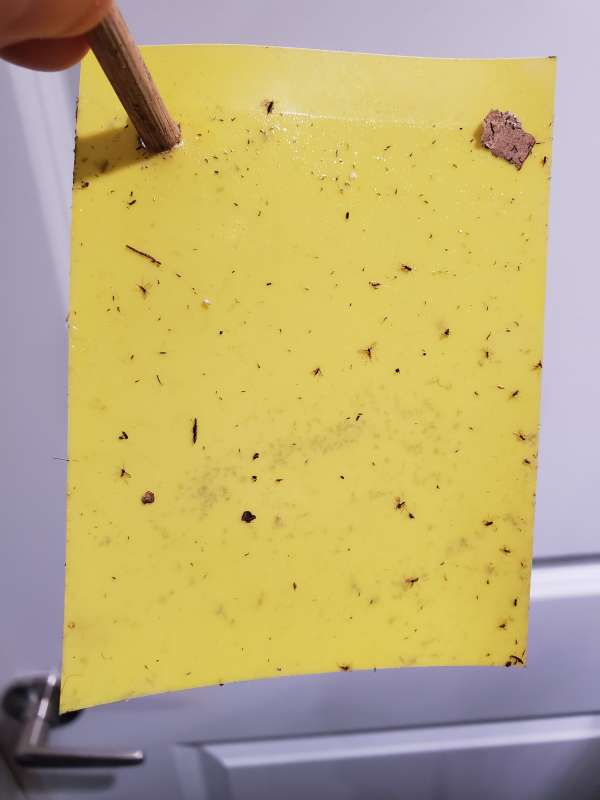
Fungus gnats on a yellow sticky trap
Fungus gnats are attracted to the yellow color, so they fly towards the sticky traps and get caught. Yellow traps can be easily purchased online and placed with your infested plants.
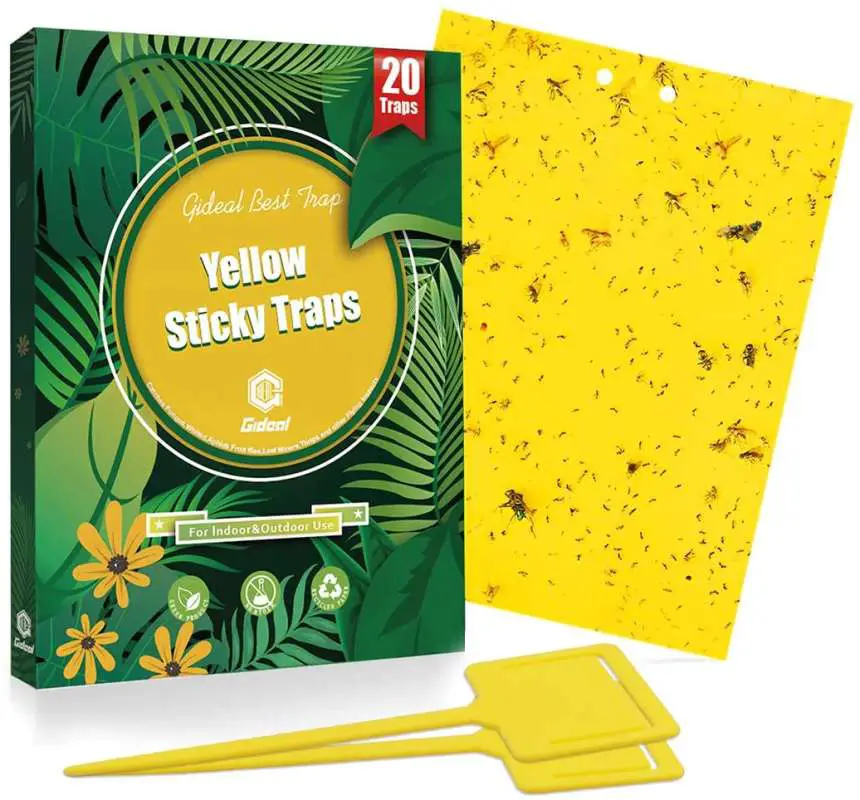
A good option is to use Yellow Sticky Traps to control fungus gnats
One package contains 20 sheets, which I cut into 4 pieces, so I get 80 traps! I hang just 1 or 2 per pot. I still have leftovers at my house from the last package I bought 2 years ago.
3. Systemic insecticide
Chemical insecticides are not my first choice but sometimes they are necessary. They come in different forms. If you’re using the ones in spray, please, resist the temptation of spraying insecticides in low ventilated areas. If you decide to use them, I suggest treating your plants in outdoor garden; you don’t want to inhale insecticides or get them on your skin. Some of them can be very harmful to human health. You can also check and ensure the pesticide is safe for indoor application before purchasing.
Or you can use a systemic insecticide that is mixed with water that you use for watering plants. As the water gets in contact with fungus gnat larvae, it will kill them. I personally use 1 teaspoon of insecticide per ½ or ¼ gallon of water and then water the plants the same way I would normally water them.
Be careful! Overdosing with systemic insecticide can easily kill your plant. Always test on one plant first, wait for a few days, and if the plant is fine, use it on other plants.
It can be risky, but if you air on the side of caution, you’ll be fine. And you’ll be free of not only fungus gnats infestation problem but other pests as well for a full year! You will get rid of thrips, scale, mealy bugs, aphids, whiteflies and many other pests. The only pest not affected are spider mites :(
4. Nematodes
You can add nematodes into the soil. Not only will these beneficial microscopic organisms kill fungus gnat larvae but will also get eradicate other soil-dwelling pests. Be careful not to mix in soil containing hydrogen peroxide solution as it can kill nematodes.
5. Hydrogen Peroxide
Another quick and easy method is to use a hydrogen peroxide solution against this common problem (the ratio is one part 3% hydrogen peroxide to four parts of water). Pour into the soil until it starts draining at the bottom; fungus gnat larvae will die immediately. Hydrogen peroxide is used to treat certain fungal root diseases as well, so if used in the right concentration, it’s pretty safe.
6. Switch to a non-organic potting medium
Fungus gnat larvae feed on a fungus found in the soil. Organic soil contains carbon-based material that is living or was once living. It consists of decaying plant material. This includes compost, manure, bark, wood chips. All of this is decaying organic matter that is great for growing fungus which acts like a magnet for fungus gnats. After all, these pests are named for it.
On the other hand, non-organic media consists of materials that are free of nutrients and contaminants, like perlite, vermiculite, expanded clay aggregate, pumice, sand. Some of them are used in hydroponics but also as soil amendments for houseplants. They do not decompose over time and do not attract gnats.
This is why I advise you to switch to a non-organic potting mix for prevention to keep away fungus gnats. No soil, no problems.
You could even try to create your own non-organic mix, which would be a combination of the components previously mentioned but you need to be aware that neither of the ingredients will hold water for long and therefore you’d have to water the plant every day, some even more than once a day.
7. Move from Soil to Hydroponics
You can eliminate larvae and stop them from breeding by moving plants from soil to water. Hydroponics is a common method of growing plants without soil, but in water, with a nutrient solution. Since there is no soil, thus no organic matter, fungus gnats have nothing to feast on, so this is a sure method to completely get rid of them.
However, hydroponics is a science of its own. Make sure to do research on how to successfully transition plants to hydroponics, how to provide oxygen to the roots, how to apply nutrient solutions, and check water PH.
8. Diatomaceous Earth
Diatomaceous Earth (DE) is a naturally occurring sedimentary rock crushed to white powder. You can apply the powder directly to the soil, making sure to cover the whole surface of the soil. As DE comes into contact with insects, it absorbs the fats from their bodies, drying them out until they die. The larvae that crawl over it will be dead in seconds.
It is crucial that the soil is dry when you apply Diatomaceous Earth. As soon as DE becomes wet, it loses its effectiveness. Here is my video on how to use DE:
8. Diatomaceous Earth
Diatomaceous Earth (DE) is a naturally occurring sedimentary rock crushed to white powder. You can apply the powder directly to the soil, making sure to cover the whole surface of the soil. As DE comes into contact with insects, it absorbs the fats from their bodies, drying them out until they die. The larvae that crawl over it will be dead in seconds.
It is crucial that the soil is dry when you apply Diatomaceous Earth. As soon as DE becomes wet, it loses its effectiveness. Here is my video on how to use DE:
9. Letting the Soil Dry Out
The consistently damp soil attracts and encourages the development of fungus gnats infestation in your home. If your plants can survive without water for a short period, you can try letting the soil dry out. Avoid watering until the soil has dried at least halfway down. For succulents, let them dry all the way down. Fungus gnats should die in dry soil. To help your plants use water more quickly and make the soil dry completely faster, give your plants more light. If you lack natural light in your home, you can use grow lights.
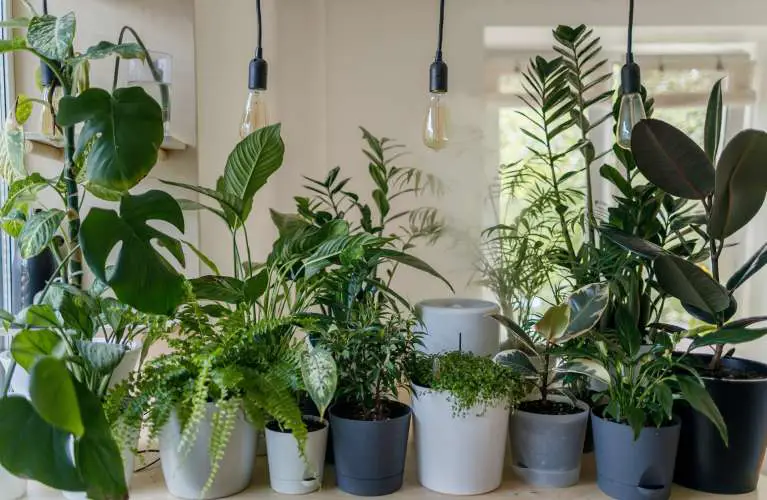
Give your houseplants more light at your house to help their soil dry out faster; photo by Vadim Kaipov, Unsplash
This method has worked relatively well for me in Serbia but has been less effective here in the US. I don’t know if fungus gnats are different here… it’s possible the species are different. That has been the experience of many people I spoke with – it worked for some, didn’t work for others. But regardless of where you live, I do recommend you try this method.
But make yourself ready to try several methods at the same time. Fungus gnats are fierce enemies, and the more removal methods you have in your arsenal, the better. 💪
10. Topdressing the Soil
Top dress the soil with one inch of sand. The sand acts as a physical barrier between the soil and the fungus gnats. As they like to feed on organic matter, this prevents them access to it and stops them from laying eggs in the soil.
Again, this method works for some people, but less so for others, as fungus gnats will still have access to soil through drainage holes in your pots.
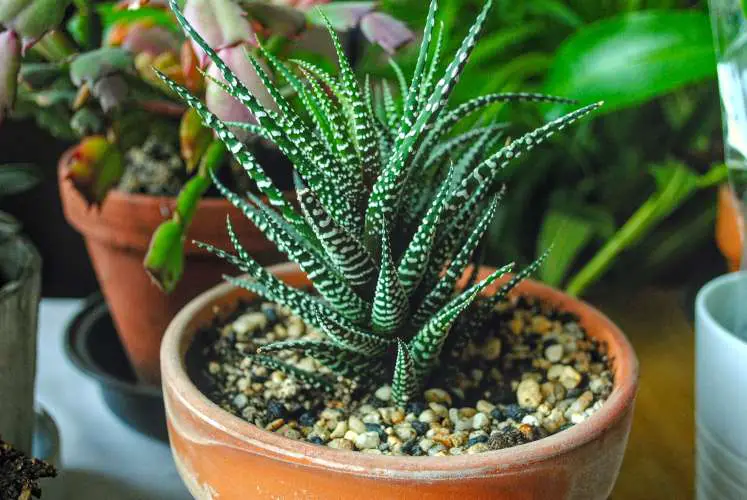
Add sand to the soil; photo by Samuel Perez, Unsplash
11. Cinnamon
I know people love using natural products to care for their houseplants, but the cold, hard truth is that many of them do not work or have scientifically not been proven to work. Cinnamon is one of them.
The idea is to sprinkle cinnamon on top of the soil, which should kill the fungus that the larvae feed on. The studies I’ve seen do show that several cinnamon components have antifungal properties, but they haven’t been tested on the same fungus that fungus gnats feed on and not in the same conditions. But you are welcome to try. Cinnamon might work and most likely won’t harm your plants. But if it doesn’t, try other methods I explained in this article.
Have More Questions on How to Get Rid of Fungus Gnats in Your Home?
I hope this article was helpful and you’re now armed with knowledge and resources to successfully combat fungus gnats in your home. Also, if you know someone struggling with fungus gnats, please share this post with them. If, however, you have more questions or any doubts, don’t hesitate to schedule a consultation session with me.
Yours Truly,

